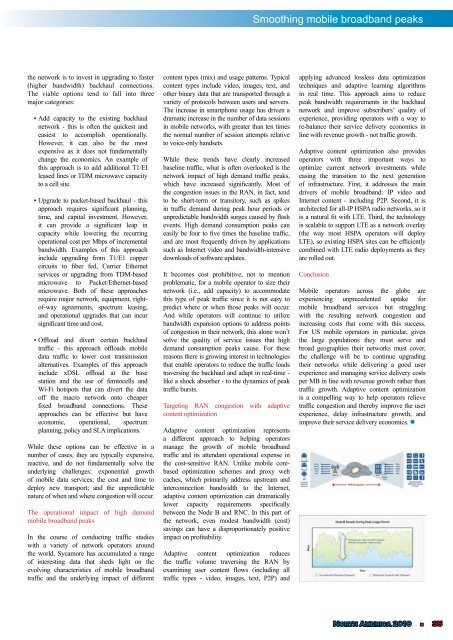As the workforce becomes wireless so does the ... - Connect-World
As the workforce becomes wireless so does the ... - Connect-World
As the workforce becomes wireless so does the ... - Connect-World
Create successful ePaper yourself
Turn your PDF publications into a flip-book with our unique Google optimized e-Paper software.
Smoothing Mobile mobile payment broadband Mobile systemsaccess peaks<strong>the</strong> network is to invest in upgrading to faster(higher bandwidth) backhaul connections.The viable options tend to fall into threemajor categories:• Add capacity to <strong>the</strong> existing backhaulnetwork - this is often <strong>the</strong> quickest andeasiest to accomplish operationally.However, it can al<strong>so</strong> be <strong>the</strong> mostexpensive as it <strong>does</strong> not fundamentallychange <strong>the</strong> economics. An example ofthis approach is to add additional T1/EIleased lines or TDM microwave capacityto a cell site.• Upgrade to packet-based backhaul - thisapproach requires significant planning,time, and capital investment. However,it can provide a significant leap incapacity while lowering <strong>the</strong> recurringoperational cost per Mbps of incrementalbandwidth. Examples of this approachinclude upgrading from T1/E1 coppercircuits to fiber fed, Carrier E<strong>the</strong>rnetservices or upgrading from TDM-basedmicrowave to Packet/E<strong>the</strong>rnet-basedmicrowave. Both of <strong>the</strong>se approachesrequire major network, equipment, rightof-wayagreements, spectrum leasing,and operational upgrades that can incursignificant time and cost.• Offload and divert certain backhaultraffic - this approach offloads mobiledata traffic to lower cost transmissionalternatives. Examples of this approachinclude xDSL offload at <strong>the</strong> basestation and <strong>the</strong> use of femtocells andWi-Fi hotspots that can divert <strong>the</strong> dataoff <strong>the</strong> macro network onto cheaperfixed broadband connections. Theseapproaches can be effective but haveeconomic, operational, spectrumplanning, policy and SLA implications.While <strong>the</strong>se options can be effective in anumber of cases, <strong>the</strong>y are typically expensive,reactive, and do not fundamentally <strong>so</strong>lve <strong>the</strong>underlying challenges: exponential growthof mobile data services; <strong>the</strong> cost and time todeploy new transport; and <strong>the</strong> unpredictablenature of when and where congestion will occur.The operational impact of high demandmobile broadband peaksIn <strong>the</strong> course of conducting traffic studieswith a variety of network operators around<strong>the</strong> world, Sycamore has accumulated a rangeof interesting data that sheds light on <strong>the</strong>evolving characteristics of mobile broadbandtraffic and <strong>the</strong> underlying impact of differentcontent types (mix) and usage patterns. Typicalcontent types include video, images, text, ando<strong>the</strong>r binary data that are transported through avariety of protocols between users and servers.The increase in smartphone usage has driven adramatic increase in <strong>the</strong> number of data sessionsin mobile networks, with greater than ten times<strong>the</strong> normal number of session attempts relativeto voice-only handsets.While <strong>the</strong>se trends have clearly increasedbaseline traffic, what is often overlooked is <strong>the</strong>network impact of high demand traffic peaks,which have increased significantly. Most of<strong>the</strong> congestion issues in <strong>the</strong> RAN, in fact, tendto be short-term or transitory, such as spikesin traffic demand during peak hour periods orunpredictable bandwidth surges caused by flashevents. High demand consumption peaks caneasily be four to five times <strong>the</strong> baseline traffic,and are most frequently driven by applicationssuch as Internet video and bandwidth-intensivedownloads of <strong>so</strong>ftware updates.It <strong>becomes</strong> cost prohibitive, not to mentionproblematic, for a mobile operator to size <strong>the</strong>irnetwork (i.e., add capacity) to accommodatethis type of peak traffic since it is not easy topredict where or when those peaks will occur.And while operators will continue to utilizebandwidth expansion options to address point<strong>so</strong>f congestion in <strong>the</strong>ir network, this alone won’t<strong>so</strong>lve <strong>the</strong> quality of service issues that highdemand consumption peaks cause. For <strong>the</strong>serea<strong>so</strong>ns <strong>the</strong>re is growing interest in technologiesthat enable operators to reduce <strong>the</strong> traffic loadstraversing <strong>the</strong> backhaul and adapt in real-time -like a shock ab<strong>so</strong>rber - to <strong>the</strong> dynamics of peaktraffic bursts.Targeting RAN congestion with adaptivecontent optimizationAdaptive content optimization representsa different approach to helping operatorsmanage <strong>the</strong> growth of mobile broadbandtraffic and its attendant operational expense in<strong>the</strong> cost-sensitive RAN. Unlike mobile corebasedoptimization schemes and proxy webcaches, which primarily address upstream andinterconnection bandwidth to <strong>the</strong> Internet,adaptive content optimization can dramaticallylower capacity requirements specificallybetween <strong>the</strong> Node B and RNC. In this part of<strong>the</strong> network, even modest bandwidth (cost)savings can have a disproportionately positiveimpact on profitability.Adaptive content optimization reduces<strong>the</strong> traffic volume traversing <strong>the</strong> RAN byexamining user content flows (including alltraffic types - video, images, text, P2P) andapplying advanced lossless data optimizationtechniques and adaptive learning algorithmsin real time. This approach aims to reducepeak bandwidth requirements in <strong>the</strong> backhaulnetwork and improve subscribers’ quality ofexperience, providing operators with a way tore-balance <strong>the</strong>ir service delivery economics inline with revenue growth - not traffic growth.Adaptive content optimization al<strong>so</strong> provide<strong>so</strong>perators with three important ways tooptimize current network investments whileeasing <strong>the</strong> transition to <strong>the</strong> next generationof infrastructure. First, it addresses <strong>the</strong> maindrivers of mobile broadband: IP video andInternet content - including P2P. Second, it isarchitected for all-IP HSPA radio networks, <strong>so</strong> itis a natural fit with LTE. Third, <strong>the</strong> technologyis scalable to support LTE as a network overlay(<strong>the</strong> way most HSPA operators will deployLTE), <strong>so</strong> existing HSPA sites can be efficientlycombined with LTE radio deployments as <strong>the</strong>yare rolled out.ConclusionMobile operators across <strong>the</strong> globe areexperiencing unprecedented uptake formobile broadband services but strugglingwith <strong>the</strong> resulting network congestion andincreasing costs that come with this success.For US mobile operators in particular, given<strong>the</strong> large populations <strong>the</strong>y must serve andbroad geographies <strong>the</strong>ir networks must cover,<strong>the</strong> challenge will be to continue upgrading<strong>the</strong>ir networks while delivering a good userexperience and managing service delivery costsper MB in line with revenue growth ra<strong>the</strong>r thantraffic growth. Adaptive content optimizationis a compelling way to help operators relievetraffic congestion and <strong>the</strong>reby improve <strong>the</strong> userexperience, delay infrastructure growth, andimprove <strong>the</strong>ir service delivery economics. •North America 2010 • 35
















